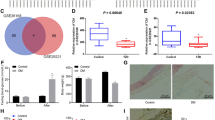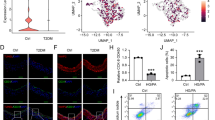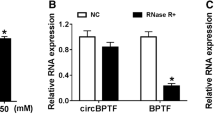Abstract
The protein PIAS1 functions as a type of ubiquitin-protease, which is known to play an important regulatory role in various diseases, including cardiovascular diseases and cancers. Its mechanism of action primarily revolves around regulating the transcription, translation, and modification of target proteins. This study investigates role and mechanism of PIAS1 in the RUNX3/TSP-1 axis and confirms its therapeutic effects on diabetes-related complications in animal models. A diabetic vascular injury was induced in human umbilical vein endothelial cells (HUVECs) by stimulation with H2O2 and advanced glycation end product (AGE), and a streptozotocin (STZ)-induced mouse model of diabetes was constructed, followed by detection of endogenous PIAS1 expression and SUMOylation level of RUNX3. Effects of PIAS1 concerning RUNX3 and TSP-1 on the HUVEC apoptosis and inflammation were evaluated using the ectopic expression experiments. Down-regulated PIAS1 expression and SUMOylation level of RUNX3 were identified in the H2O2- and AGE-induced HUVEC model of diabetic vascular injury and STZ-induced mouse models of diabetes. PIAS1 promoted the SUMOylation of RUNX3 at the K148 site of RUNX3. PIAS1-mediated SUMOylation of RUNX3 reduced RUNX3 transactivation activity, weakened the binding of RUNX3 to the promoter region of TSP-1, and caused downregulation of TSP-1 expression. PIASI decreased the expression of TSP-1 by inhibiting H2O2- and AGE-induced RUNX3 de-SUMOylation, thereby arresting the inflammatory response and apoptosis of HUVECs. Besides, PIAS1 reduced vascular endothelial injury and atherosclerotic plaque formation in mouse models of diabetes by inhibiting the RUNX3/TSP-1 axis. Our study proved that PIAS1 suppressed vascular endothelial injury and atherosclerotic plaque formation in mouse models of diabetes via the RUNX3/TSP-1 axis.







Similar content being viewed by others
Data availability
The datasets used and analyzed during the current study are available from the corresponding author upon reasonable request.
References
American DA. Diagnosis and classification of diabetes mellitus. Diabetes Care. 2013;36(Suppl 1):S67-74. https://doi.org/10.2337/dc13-S067.
Cloete L. Diabetes mellitus: an overview of the types, symptoms, complications and management. Nurs Stand. 2022;37:61–6. https://doi.org/10.7748/ns.2021.e11709.
Lind M, Svensson AM, Kosiborod M, et al. Glycemic control and excess mortality in type 1 diabetes. N Engl J Med. 2014;371:1972–82. https://doi.org/10.1056/NEJMoa1408214.
Wang R, Wang M, Ye J, Sun G, Sun X. Mechanism overview and target mining of atherosclerosis: endothelial cell injury in atherosclerosis is regulated by glycolysis. Int J Mol Med. 2021;47:65–76. https://doi.org/10.3892/ijmm.2020.4798. (Review).
Wen T, Hong Y, Cui Y, et al. Downregulation of miR-210–3p attenuates high glucose-induced angiogenesis of vascular endothelial cells via targeting FGFRL1. Ophthalmic Res. 2023. https://doi.org/10.1159/000530160.
Sardu C, Trotta MC, Sasso FC, et al. SGLT2-inhibitors effects on the coronary fibrous cap thickness and MACEs in diabetic patients with inducible myocardial ischemia and multi vessels non-obstructive coronary artery stenosis. Cardiovasc Diabetol. 2023;22:80. https://doi.org/10.1186/s12933-023-01814-7.
Constanzo JD, Deng M, Rindhe S, et al. Pias1 is essential for erythroid and vascular development in the mouse embryo. Dev Biol. 2016;415:98–110. https://doi.org/10.1016/j.ydbio.2016.04.013.
Liu Y, Ge X, Dou X, et al. Protein inhibitor of activated STAT 1 (PIAS1) protects against obesity-induced insulin resistance by inhibiting inflammation cascade in adipose tissue. Diabetes. 2015;64:4061–74. https://doi.org/10.2337/db15-0278.
Leng C, Sun J, Xin K, et al. High expression of miR-483-5p aggravates sepsis-induced acute lung injury. J Toxicol Sci. 2020;45:77–86. https://doi.org/10.2131/jts.45.77.
Schutz E, Gogiraju R, Pavlaki M, et al. Age-dependent and -independent effects of perivascular adipose tissue and its paracrine activities during neointima formation. Int J Mol Sci. 2019. https://doi.org/10.3390/ijms21010282.
Kim JH, Jang JW, Lee YS, et al. RUNX family members are covalently modified and regulated by PIAS1-mediated sumoylation. Oncogenesis. 2014;3:e101. https://doi.org/10.1038/oncsis.2014.15.
Menezes AC, Dixon C, Scholz A, et al. RUNX3 overexpression inhibits normal human erythroid development. Sci Rep. 2022;12:1243. https://doi.org/10.1038/s41598-022-05371-z.
Meng S, Cao J, Zhang X, et al. Downregulation of microRNA-130a contributes to endothelial progenitor cell dysfunction in diabetic patients via its target Runx3. PLoS ONE. 2013;8:e68611. https://doi.org/10.1371/journal.pone.0068611.
Shi X, Deepak V, Wang L, et al. Thrombospondin-1 is a putative target gene of Runx2 and Runx3. Int J Mol Sci. 2013;14:14321–32. https://doi.org/10.3390/ijms140714321.
Roberts DD, Isenberg JS. CD47 and thrombospondin-1 regulation of mitochondria, metabolism, and diabetes. Am J Physiol Cell Physiol. 2021;321:C201–13. https://doi.org/10.1152/ajpcell.00175.2021.
Kong P, Cavalera M, Frangogiannis NG. The role of thrombospondin (TSP)-1 in obesity and diabetes. Adipocyte. 2014;3:81–4. https://doi.org/10.4161/adip.26990.
Hu H, Wang B, Jiang C, Li R, Zhao J. Endothelial progenitor cell-derived exosomes facilitate vascular endothelial cell repair through shuttling miR-21-5p to modulate Thrombospondin-1 expression. Clin Sci (Lond). 2019;133:1629–44. https://doi.org/10.1042/CS20190188.
Ganguly R, Khanal S, Mathias A, et al. TSP-1 (thrombospondin-1) deficiency protects ApoE(−/−) mice against leptin-induced atherosclerosis. Arterioscler Thromb Vasc Biol. 2021;41:e112–27. https://doi.org/10.1161/ATVBAHA.120.314962.
Wang F, Ge J, Huang S, et al. KLF5/LINC00346/miR-148a-3p axis regulates inflammation and endothelial cell injury in atherosclerosis. Int J Mol Med. 2021. https://doi.org/10.3892/ijmm.2021.4985.
Kocherova I, Bryja A, Mozdziak P, et al. Human umbilical vein endothelial cells (HUVECs) co-culture with osteogenic cells: from molecular communication to engineering prevascularised bone grafts. J Clin Med. 2019. https://doi.org/10.3390/jcm8101602.
Lan D, Shen X, Yuan W, Zhou Y, Huang Q. Sumoylation of PPARgamma contributes to vascular endothelium insulin resistance through stabilizing the PPARgamma-NcoR complex. J Cell Physiol. 2019;234:19663–74. https://doi.org/10.1002/jcp.28567.
Li P, Chen D, Cui Y, et al. Src plays an important role in AGE-induced endothelial cell proliferation, migration, and tubulogenesis. Front Physiol. 2018;9:765. https://doi.org/10.3389/fphys.2018.00765.
Ganguly R, Sahu S, Ohanyan V, et al. Oral chromium picolinate impedes hyperglycemia-induced atherosclerosis and inhibits proatherogenic protein TSP-1 expression in STZ-induced type 1 diabetic ApoE(−/−) mice. Sci Rep. 2017;7:45279. https://doi.org/10.1038/srep45279.
He Y, Lu J, Ye Z, et al. Androgen receptor splice variants bind to constitutively open chromatin and promote abiraterone-resistant growth of prostate cancer. Nucleic Acids Res. 2018;46:1895–911. https://doi.org/10.1093/nar/gkx1306.
Zong P, Feng J, Yue Z, et al. TRPM2 deficiency in mice protects against atherosclerosis by inhibiting TRPM2-CD36 inflammatory axis in macrophages. Nat Cardiovasc Res. 2022;1:344–60. https://doi.org/10.1038/s44161-022-00027-7.
Dou M, Chen Y, Hu J, Ma D, Xing Y. Recent advancements in CD47 signal transduction pathways involved in vascular diseases. Biomed Res Int. 2020;2020:4749135. https://doi.org/10.1155/2020/4749135.
Hou Z, Chen J, Yang H, Hu X, Yang F. PIAS1 alleviates diabetic peripheral neuropathy through SUMOlation of PPAR-gamma and miR-124-induced downregulation of EZH2/STAT3. Cell Death Discov. 2021;7:372. https://doi.org/10.1038/s41420-021-00765-w.
Hou G, Zhao X, Li L, et al. SUMOylation of YTHDF2 promotes mRNA degradation and cancer progression by increasing its binding affinity with m6A-modified mRNAs. Nucleic Acids Res. 2021;49:2859–77. https://doi.org/10.1093/nar/gkab065.
Bettermann K, Benesch M, Weis S, Haybaeck J. SUMOylation in carcinogenesis. Cancer Lett. 2012;316:113–25. https://doi.org/10.1016/j.canlet.2011.10.036.
Sireesh D, Bhakkiyalakshmi E, Ramkumar KM, et al. Targeting SUMOylation cascade for diabetes management. Curr Drug Targets. 2014;15:1094–106. https://doi.org/10.2174/1389450115666140915124747.
Shishido T, Woo CH, Ding B, et al. Effects of MEK5/ERK5 association on small ubiquitin-related modification of ERK5: implications for diabetic ventricular dysfunction after myocardial infarction. Circ Res. 2008;102:1416–25. https://doi.org/10.1161/CIRCRESAHA.107.168138.
Woo CH, Shishido T, McClain C, et al. Extracellular signal-regulated kinase 5 SUMOylation antagonizes shear stress-induced antiinflammatory response and endothelial nitric oxide synthase expression in endothelial cells. Circ Res. 2008;102:538–45. https://doi.org/10.1161/CIRCRESAHA.107.156877.
Li CL, Liu XH, Qiao Y, et al. Allicin alleviates inflammation of diabetic macroangiopathy via the Nrf2 and NF-kB pathway. Eur J Pharmacol. 2020;876:173052. https://doi.org/10.1016/j.ejphar.2020.173052.
Nikhil K, Sharan S, Wishard R, et al. Pterostilbene carboxaldehyde thiosemicarbazone, a resveratrol derivative inhibits 17beta-Estradiol induced cell migration and proliferation in HUVECs. Steroids. 2016;108:17–30. https://doi.org/10.1016/j.steroids.2016.01.020.
Wang XH, Xu B, Liu JT, Cui JR. Effect of beta-escin sodium on endothelial cells proliferation, migration and apoptosis. Vascul Pharmacol. 2008;49:158–65. https://doi.org/10.1016/j.vph.2008.07.005.
Xing C, Lee S, Kim WJ, et al. Neurovascular effects of CD47 signaling: promotion of cell death, inflammation, and suppression of angiogenesis in brain endothelial cells in vitro. J Neurosci Res. 2009;87:2571–7. https://doi.org/10.1002/jnr.22076.
Jin Q, Lin L, Zhao T, et al. Overexpression of E3 ubiquitin ligase Cbl attenuates endothelial dysfunction in diabetes mellitus by inhibiting the JAK2/STAT4 signaling and Runx3-mediated H3K4me3. J Transl Med. 2021;19:469. https://doi.org/10.1186/s12967-021-03069-w.
Hu R, Wang MQ, Ni SH, et al. Salidroside ameliorates endothelial inflammation and oxidative stress by regulating the AMPK/NF-kappaB/NLRP3 signaling pathway in AGEs-induced HUVECs. Eur J Pharmacol. 2020;867:172797. https://doi.org/10.1016/j.ejphar.2019.172797.
Zhao LY, Li J, Yuan F, et al. Xyloketal B attenuates atherosclerotic plaque formation and endothelial dysfunction in apolipoprotein e deficient mice. Mar Drugs. 2015;13:2306–26. https://doi.org/10.3390/md13042306.
Pirillo A, Norata GD, Catapano AL. LOX-1, OxLDL, and atherosclerosis. Mediators Inflamm. 2013;2013:152786. https://doi.org/10.1155/2013/152786.
Acknowledgements
We acknowledge and appreciate our colleagues’ valuable efforts and comments on this paper.
Funding
This study is supported by the National Natural Science Foundation of China (No. 81273200).
Author information
Authors and Affiliations
Contributions
QJ, TZ, and LL wrote the paper and conceived and designed the experiments. XY, YT, and DZ analyzed the data. YJ and MY collected and provided the sample for this study. All authors have read and approved the final submitted manuscript.
Corresponding authors
Ethics declarations
Conflict of interest
The authors declare that there is no conflict of interest.
Ethical approval
The animal study was approved by the Institutional Animal Care and Use Committee (IACUC) of Yantai Affiliated Hospital of Binzhou Medical College (IRB2022-0043). Animal experiments were strictly designed and implemented according to the Guide for the Care and Use of Laboratory Animals published by the US National Institutes of Health.
Informed consent
Consent for publication was obtained from the participants.
Additional information
Publisher's Note
Springer Nature remains neutral with regard to jurisdictional claims in published maps and institutional affiliations.
Supplementary Information
Below is the link to the electronic supplementary material.
13577_2023_952_MOESM2_ESM.eps
Supplementary Fig. S2 TUNEL staining test for apoptosis of cells in each group after stimulation by H2O2 or AGE. A: TUNEL staining test for apoptosis of cells in each group after H2O2 stimulation (400×); B: TUNEL staining test for apoptosis of cells in each group after AGE stimulation (400×). The experiment was repeated three times (EPS 2628 KB)
Rights and permissions
Springer Nature or its licensor (e.g. a society or other partner) holds exclusive rights to this article under a publishing agreement with the author(s) or other rightsholder(s); author self-archiving of the accepted manuscript version of this article is solely governed by the terms of such publishing agreement and applicable law.
About this article
Cite this article
Jin, Q., Zhao, T., Lin, L. et al. PIAS1 impedes vascular endothelial injury and atherosclerotic plaque formation in diabetes by blocking the RUNX3/TSP-1 axis. Human Cell 36, 1915–1927 (2023). https://doi.org/10.1007/s13577-023-00952-0
Received:
Accepted:
Published:
Issue Date:
DOI: https://doi.org/10.1007/s13577-023-00952-0




